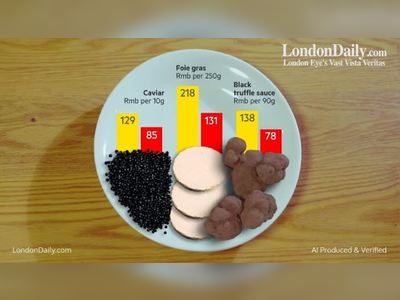
Understanding Inflation: Latest UK Rate Drop Provides Temporary Relief
UK Inflation Rate Sees Unexpected Decline to 2.5% - What It Means for the Economy
In December, the United Kingdom experienced a modest yet unexpected drop in its inflation rate, which eased to 2.5% from 2.6% in the previous month.
The Office for National Statistics (ONS), responsible for calculating the country's inflation figures, highlighted that while price increases remain above the Bank of England's target, there is growing anticipation for potential interest rate adjustments in the near future.
This reduction grants some reprieve for Chancellor Rachel Reeves, who has been managing the challenges posed by a weakening pound and surging government borrowing costs, the latter reaching unprecedented levels in years.
Notably, the pound experienced a minor uptick to $1.22 on Wednesday, and the UK's borrowing costs showed slight easing.
The primary factors contributing to the decline in inflation include smaller price hikes in tobacco compared to the previous year, as well as decreases in hotel rates, and clothing and footwear prices.
Conversely, higher petrol and used car prices have partly offset these gains, as noted by ONS chief economist Grant Fitzner.
What is Inflation?
Inflation represents the rate at which prices for goods and services increase, leading to a reduction in purchasing power.
As inflation rises, each unit of currency buys fewer goods and services.
Key Points of Inflation
Rising Prices: Consumers may notice increases in everyday costs such as groceries, fuel, housing, and transportation.
For example, a 3% inflation rate implies that a £100 item would cost £103 a year later.
Decreased Purchasing Power: Money loses its value over time when inflation occurs.
Measurement in the UK
Inflation is commonly measured by the Consumer Prices Index (CPI), which tracks the price changes of a typical basket of goods and services.
Another measure, the Retail Prices Index (RPI), is similar but includes mortgage interest payments.
Causes of Inflation
Several factors drive inflation, typically divided into demand-pull and cost-push inflation.
Demand-Pull: Arises from high consumer demand exceeding supply, driven by increased spending, fiscal policies, or decreased interest rates.
Cost-Push: Results from escalating production costs being transferred to consumers, such as rising raw material or labor costs, supply chain disruptions, or geopolitical tensions.
Other factors influencing inflation include global commodity prices and currency exchange rates.
Central banks, like the Bank of England, utilize monetary policies targeting inflation, usually aiming for around 2% annually.
Impact on Mortgages and Wages
Mortgages: Rising inflation can lead to increased interest rates, affecting those with variable and tracker-rate mortgages.
Fixed-rate mortgage holders are shielded temporarily but may face higher costs when their terms reset.
Wages: Without corresponding pay increases, inflation diminishes income value.
Workers might demand higher wages; if unmet, this reduces their real purchasing power.
While inflation's immediate effects on individual sectors such as wages, mortgages, and everyday consumer goods are significant, the broader implications on economic health cannot be overstated.
Periodic tracking and addressing of inflation are crucial as part of economic governance.
The Office for National Statistics (ONS), responsible for calculating the country's inflation figures, highlighted that while price increases remain above the Bank of England's target, there is growing anticipation for potential interest rate adjustments in the near future.
This reduction grants some reprieve for Chancellor Rachel Reeves, who has been managing the challenges posed by a weakening pound and surging government borrowing costs, the latter reaching unprecedented levels in years.
Notably, the pound experienced a minor uptick to $1.22 on Wednesday, and the UK's borrowing costs showed slight easing.
The primary factors contributing to the decline in inflation include smaller price hikes in tobacco compared to the previous year, as well as decreases in hotel rates, and clothing and footwear prices.
Conversely, higher petrol and used car prices have partly offset these gains, as noted by ONS chief economist Grant Fitzner.
What is Inflation?
Inflation represents the rate at which prices for goods and services increase, leading to a reduction in purchasing power.
As inflation rises, each unit of currency buys fewer goods and services.
Key Points of Inflation
Rising Prices: Consumers may notice increases in everyday costs such as groceries, fuel, housing, and transportation.
For example, a 3% inflation rate implies that a £100 item would cost £103 a year later.
Decreased Purchasing Power: Money loses its value over time when inflation occurs.
Measurement in the UK
Inflation is commonly measured by the Consumer Prices Index (CPI), which tracks the price changes of a typical basket of goods and services.
Another measure, the Retail Prices Index (RPI), is similar but includes mortgage interest payments.
Causes of Inflation
Several factors drive inflation, typically divided into demand-pull and cost-push inflation.
Demand-Pull: Arises from high consumer demand exceeding supply, driven by increased spending, fiscal policies, or decreased interest rates.
Cost-Push: Results from escalating production costs being transferred to consumers, such as rising raw material or labor costs, supply chain disruptions, or geopolitical tensions.
Other factors influencing inflation include global commodity prices and currency exchange rates.
Central banks, like the Bank of England, utilize monetary policies targeting inflation, usually aiming for around 2% annually.
Impact on Mortgages and Wages
Mortgages: Rising inflation can lead to increased interest rates, affecting those with variable and tracker-rate mortgages.
Fixed-rate mortgage holders are shielded temporarily but may face higher costs when their terms reset.
Wages: Without corresponding pay increases, inflation diminishes income value.
Workers might demand higher wages; if unmet, this reduces their real purchasing power.
While inflation's immediate effects on individual sectors such as wages, mortgages, and everyday consumer goods are significant, the broader implications on economic health cannot be overstated.
Periodic tracking and addressing of inflation are crucial as part of economic governance.










